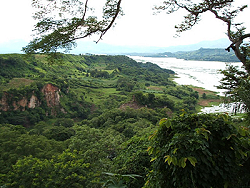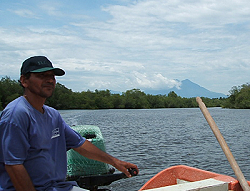
Photo. Near Suchitoto in El Salvador. © Alex Welsh.
El Salvador was almost an accident. In the summer of 2005 I was on my way from the South to the North of Mexico when the proximity of the Guatemalan border sucked me in. Guatemala was nice but my time was very limited and the terrain didn’t allow to go too far off the Great Central American Dope Trail. The Lonely Planet felt particularly evil on that trip. Everyone was on the way to that village where turtles lay eggs, their noses buried in the book. I suddenly realised that I don’t know a single person at home who has ever considered watching turtles lay eggs. This abnormality, plus Bob Marley, the stench of dope and fashion cult of the indigenous made me dizzy. Luckily I met Luke and we decided to escape to El Salvador. Because no one else did.
Why? There are a few reasons. Some people read in the Lonely Planet that there isn’t that much to see. In addition, it’s way too off the main drag – Guatemala to Utila, North Honduras, where everyone has to scuba dive. Yet others feel nervous. In case you were not aware, the civil war in El Salvador finished in 1992, after 12 years of brutal carnage. But people got so used to sleeping with firearms that the country is still armed to the teeth. For many years after the war the streets remained violent and gangs multiplied. All in all, El Salvador has a reputation of a small, out of the way, dangerous country with not much too see. Great, more for us.
We met a couple of people who had been to San Salvador airport and then jumped onto a bus straight to Guatemala, but we failed to meet anyone who had actually seen the country. So we didn’t know what to expect and we were nervous too.
It was a pleasant ride, with plenty of coastal colours. In 2 hours we had already crossed a third of the country and arrived to the capital. San Salvador immediately charmed us with its phlegmatic and strong presence. For a capital, and after Guatemala City, there was quite a sense of order, a sense that things have a direction and are more or less under control. Although it is a city where edges are in all respects sharper, a city that may show you teeth from time to time, chaos definitely would not be part of the description.
The scars of the war appeared immediately, however. There were no ruins but as we were checking into the hostel we were received by a one-armed lady and as soon as we walked out we bought a coconut from a one-legged old woman.
As for danger, we didn’t feel it. But that day we did stay in a heavily protected part of the city. Over time I decided that El Salvador was only slightly more dangerous than Guatemala. It is one of those countries, like Colombia, great to visit while everyone still thinks it is unsafe. The shotguns were indeed numerous: at a pharmacy, at an internet-café, at McDonalds. You would see one every 50-100 metres. But they were all security. Normal people kept guns at home and walked around with machetes. Those were everywhere. I still don’t know if it’s just a universal household item, or a poor man's shotgun.
However, for Luke this was a disappointment. Guns were the reason he came to El Salvador. He had read in his Lonely Planet that you could buy them on a market. So we spent the whole first day trying to do that, he would just come up to the stalls and ask if they sell shotguns. Eventually we realised that LP betrayed us. Again. We did find lots of holsters though and bought two huge machetes, just to blend in.
Next day Luke remembered that in Cambodia (another everyone-has-a-gun country) they had shooting ranges. So we had a drink in the evening and decided to ask the girl at the hostel reception if there is one around here. But all we could manage in our broken Spanish was "donde es possible alquiller armas?". The worried girl dialed the manager's home number and said that two drunk gringos are asking where they can hire guns right now. We had lots of explaining to do in the morning and I began feeling stupid.
Luke was running out of options. Throughout the next day he kept coming up to security guards on the streets and leech them with "I want to play with you gun. Let’s go to the field. I'll pay you". Some politely shook their heads, some frowned (naturally, the phrase could be misinterpreted). The following morning destroyed Luke decided that enough is enough and crossed over to Honduras.
If you stay in El Salvador for a while, you do tend to spend a lot of time in the capital. It is not that San Salvador is that fascinating. It is quite low on things to see, in fact, seeming more residential. Particularly unpleasant is the stuffed centre, which has turned into one dirty market. But the country is so small and the travel arranged in such manner, that it is much more practical to venture to and fro the capital, wherever you go, unless you get far East. However, the city is fairly pleasant and has decent places to go, both in the day and at night, and a more cosmopolitan atmosphere. Besides, tourism there is still new and it is mainly the capital that can offer decent hostels (even there you will find only a few).
The most travelled route here is south to the coast. Beaches like El Zonte and El Sunzal are considered the best surf in Central America and it’s such a large chunk of the (tiny) tourist economy that you are likely to be approached in San Salvador with “Are you a surfer”? La Libertad is the coastal hub town that serves as a portal for the string of those beaches. By day everyone in that town looks like a pirate and by night they still do, but spun out on crack. It was a hot and stuffy town and, to be honest, only good for buying some fruit, so there’s just no reason not to make the extra 10km down the line. I say this because I met a few people who didn’t bother. Those beaches are not great but they are ok and convenient so most Salvadorians from the capital go there. Entirely volcanic, they make you totally black. A storm in El Salvador, viewed from those beaches, is really something special, with spectacular thunder and lightening.
My friend Maria also took me to El Cuco beach, in the East of the country. Another popular spot, it was again ok, but nothing fantastic. The amazing thing though was that this well-known beach was entirely domestic, with no thought given to (non-existent) tourists. To get there we had to cross river Lempa on a newly constructed bridge. The previous one was destroyed during the war and a third of the country had been almost entirely isolated for many years. The East has always been poorer and suffered more in that war, it is still slightly more edgy. San Miguel, the major city of that area, is a Dusk till Dawn haunt. Once the darkness comes people seal themselves in and the beasts walk the streets.
Maria gave me a little tour of the country, through places like L’Herradura, Zacatecoluca and Usulutan. It was an off the beaten track dream. The little tourist awareness that the West of the country has was entirely absent here. A virgin land, free of any pretence. A pure and genuine welcome.
| Photo. Francisco, the boatman in Herradura. © Alex Welsh. |  |
Santa Ana, a major Western city was quite sleepy but it had a lot of clowns. Don’t ask, I know it’s bizarre. I had a clown in my pizzeria, a clown in my hostel and I even ended up going for drinks with a bunch of clowns. You could say it was a fun night. By the way, make sure it is a hostel, not a “hostel”, unless eavesdropping on cries of passion is your thing – the Lonely Planet should do a more thorough research there.
The centre of the country, around the capital and to the north is very cosy and modestly lush. There are some very pleasant routes amongst hills and lakes. Then, there is Perquin – a place scarred by the history of the war. Ex-guerrillas will show you around the civil war museum.
El Salvador is not famous for any of its attractions. It doesn’t have anything particularly special but it does have the usual set of things that could occupy you. Bohemia and nightlife in San Salvador, acceptable beaches with a famous surf, volcanoes (one of which is a pure mountain of ash) where you can do scuba diving in the lakes, a national reserve El Impossible with rich wildlife, colonial towns like Suchitoto, Mayan ruins like Joya de Ceren. It is a pleasant, aesthetic country to see from a bus window, with many charming corners.
And I don’t want to be cheesy but I did go to El Salvador in the first place to just meet some regular, genuine people and I do like the Salvadorians a lot. Generous, friendly, tranquil, they also had this hard inner core, this dignity and respect for themselves and others. Many had scars of sadness in their eyes, they have had a difficult life, and it is their inexplicable strength, discipline and a sense of quiet pride that raised the country so fast from the ruins. They were really easy to relate to, it is a place where the culture gap is not as sharp as in many other places. But this article is about the country, I will tell you about the people in the next one.
El Salvador doesn’t have Machu Pichu or Foz de Iguacu. You can easily skip it if you are after high impact photos. But for someone who just wants to get away from the industry and wander around an unpolluted social landscape, this is one of the last places in the Latin America. I didn’t want it to be great, just genuine and good, and it was really good.
As for the safety, I found nothing out of the ordinary (by Central American standards) apart from a few more shotguns than in Guatemala. Normal precautions apply. Buses don’t go after dark, guns are not allowed in bars and everyone talks about violence. On that last point – myth or reality? I would say that some bodies have now become ghosts.
Read more about El Salvador in Alex Welsh`s article: El Salvador - The thoughts!
Alex Welsh, 12 September 2006
Additional information
Alex is the webmaster of Valencia City Guide - an independent resource on travelling in Valencia, Spain.
